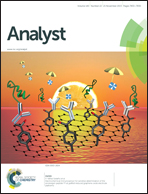Restricted access molecularly imprinted polymers obtained by bovine serum albumin and/or hydrophilic monomers’ external layers: a comparison related to physical and chemical properties
Abstract
Molecularly imprinting polymers (MIPs) can be modified with external layers in order to obtain restricted access molecularly imprinted polymers (RAMIPs) able to exclude macromolecules and retain low weight compounds. These modifications have been frequently achieved using hydrophilic monomers, chemically bound on the MIP surface. Recently, our group proposed a new biocompatible RAMIP based on the formation of a bovine serum albumin coating on the surface of MIP particles. This material has been used to extract drugs directly from untreated human plasma samples, but its physicochemical evaluation has not been carried out yet, mainly in comparison with RAMIPs obtained by hydrophilic monomers. Thus, we proposed in this paper a comparative study involving the surface composition, microscopic aspect, selectivity, binding kinetics, adsorption and macromolecule elimination ability of these different materials. We concluded that the synthesis procedure influences the size and shape of particles and that hydrophilic co-monomer addition as well as coating with BSA do not alter the chemical recognition ability of the material. The difference between imprinted and non-imprinted polymers’ adsorption was evident (suggesting that imprinted polymers have a better capacity to bind the template than the non-imprinted ones). The Langmuir model presents the best fit to describe the materials’ adsorption profile. The polymer covered with hydrophilic monomers presented the best adsorption for the template in an aqueous medium, probably due to a hydrophilic layer on its surface. We also concluded that an association of the hydrophilic monomers with the bovine serum albumin coating is important to obtain materials with higher capacity of macromolecule exclusion.


 Please wait while we load your content...
Please wait while we load your content...